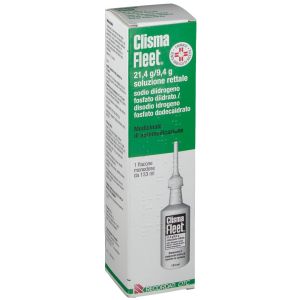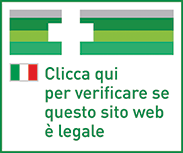Ship in Europe, Find out rates!
Language
Fleet Enema Ready To Use*133 Ml

Regular Price
€6.00
Special Price
€2.92
-51%
Save: €3.08
In stock
Recent lowest price:
€2.77
- box Delivery in Italy in 24/48 and free returns
- star3.000+ positive reviews
- dropboxOver 60,000 products in the catalog
Manufacturer
CASEN RECORDATI SL
SKU
029319011
Active principle
SODIO FOSFATO MONOBASICO/SODIO FOSFATO BIBASICO
NAME
CLISMA FLEET 21.4 G / 9.4 G RECTAL SOLUTION
PHARMACOTHERAPEUTIC CATEGORY
Enemas, sodium phosphate.
ACTIVE PRINCIPLES
Sodium dihydrogen phosphate dihydrate, disodium hydrogen phosphate dodecahydrate.
EXCIPIENTS
Benzalkonium chloride, disodium edetate, distilled water qs
INDICATIONS
Short-term treatment of occasional constipation in adults and children over 3 years of age; bowel emptying before and after surgery, in obstetrics, in preparation for radioscopic examinations and endoscopic investigations of the last intestinal tract.
CONTRAINDICATIONS / SECONDARY EFFECT
The medicine is contraindicated in patients with: hypersensitivity to the active substances or to any of the listed excipients; conditions that cause an increase in absorption capacity, a decrease in elimination capacity or a decrease in gastric motility, for example: suspected intestinal obstruction or paralytic ileus or anorectal stenosis, perforated anus, congenital megacolon, acquired or Hirschsprung's disease; undiagnosed gastrointestinal disorders, for example: symptoms indicative of appendicitis, intestinal perforation, active inflammatory bowel disease, undiagnosed rectal bleeding; congestive heart failure; dehydration; children under the age of 3; clinically significant renal insufficiency. Other preparations with sodium phosphates, including oral solutions or sodium phosphate tablets, should not be administered at the same time.
DOSAGE
Adults and children over 12 years of age: 1 bottle (118 ml delivered dose) no more than once a day. Children aged between 3 and 12 years: halved dose no more than once a day. The drug is contraindicated in children younger than 3 years. In occasional constipation, laxatives should be used as infrequently as possible and for no more than seven days. Use for longer periods of time requires a doctor's prescription after adequate evaluation of the case. Renal insufficiency: do not administer to patients with clinically significant impairment of renal function. The product should be used with caution in patients with impaired renal function, when the clinical benefit is expected to outweigh the risk of hyperphosphataemia. >> Method of administration. For usorectal only: Lie on your left side with both knees bent, arms at rest. Remove the orange protective cap with constant pressure, gently insert the Enema Comfortip into the anus with the cannula facing the navel. Squeeze the bottle until almost all of the liquid comes out. Discontinue use if resistance is encountered. Forcing the enema can cause injury. 2 to 5 minutes are enough to achieve the desired effect. For occasional constipation, rectal enemas are used to provide relief and only in the short term.
STORAGE
Do not store above 25 degrees C.
WARNINGS
Do not use the medicine in case of nausea, vomiting or pain. Patients should be advised to expect liquid stools and encouraged to drink fluids to help prevent dehydration, particularly patients with conditions that may predispose to dehydration or those taking medications that can decrease glomerular filtration rate, such as diuretics. , angiotensin converting enzyme inhibitors (ACE inhibitors), angiotensin receptor blockers (sartans) or non-steroidal anti-inflammatory drugs (NSAIDs). Since the product contains sodium phosphates, there is a risk of elevated serum sodium and phosphate levels and decreases in calcium and potassium levels and consequently hypernatremia, hyperphosphataemia, hypocalcemia and hypokalaemia which can occur with clinical signs such as tetany and insufficiency. renal. Fluid and electrolyte changes are of particular concern in children with megacolon or any other condition in which enema solution retention occurs, and in patients with co-morbidities. This is why the drug should be used with caution in: elderly or weakened patients and in patients with uncontrolled arterial hypertension, ascites, heart disease, changes in the rectal mucosa (ulcers, cracks); people with colostomy, patients who are taking diuretics or other medicines that can change fluid and electrolyte levels; subjects who are taking medicines known to prolong the QT interval or with known water and electrolyte imbalance, such as hypocalcemia, hypokalaemia, hyperphosphataemia, hypernatremia. Also use with caution in patients taking medicinal products known to affect perfusion, renal function, or hydration status. Where there is suspicion of electrolyte disturbances and a risk of hyperphosphataemia, hydroelectrolyte levels should be monitored before and after administration of the medicinal product. The product should be used with caution in patients with impaired renal function, when the clinical benefit is expected to outweigh the risk of hyperphosphataemia. Repeated and prolonged use of the drug is not recommended as it can cause addiction. Administering more than one enema in a 24 hour period can be harmful. The product should not be used for more 'than a week. The medicine should be administered according to the instructions for use. Patients should be advised to discontinue administration if resistance is encountered, as forced administration of the enema can cause injury. Rectal bleeding after using the drug may indicate a serious condition. In this case the administration must be stopped immediately. In general, evacuation occurs approximately 5 minutes after administration of the medicine, therefore, retention times of more than 5 minutes are not recommended. In the event that evacuation does not occur after using the product or if the retention time lasts more than 10 minutes, serious side effects may occur. No other administrations should be used and the patient's condition should be evaluated in order to identify any hydroelectrolytic alterations and to minimize the risk of severe hyperphosphataemia. Due to the presence of benzalkonium chloride, the product is irritating and can cause local skin reactions.
INTERACTIONS
Use with caution in patients who are on calcium channel blockers, diuretics, lithium or other medicinal products that may affect fluid and electrolyte levels as hyperphosphataemia, hypocalcaemia, hypokalaemia, acidosis and hypernatremic dehydration may occur. Other sodium phosphatide preparations including oral solutions or sodium phosphate tablets should not be administered at the same time. Since hypernatremia is associated with low lithium levels, concomitant use of the product and lithium may cause a decrease in serum lithium levels with a decrease in efficacy.
SIDE EFFECTS
The drug is well tolerated when used as directed. However, adverse events associated with drug use have frequently been reported. In some cases, adverse events may occur, especially if the enema is used inappropriately. Within each frequency group, undesirable effects are reported in decreasing order of severity. Undesirable effects are listed below, based on MedDRA system organ class and using the following frequency: very common (> = 1/10), common (> = 1/100, <1/10), uncommon (> = 1 / 1,000, <1/100), rare (> = 1 / 10,000, <1 / 1,000), very rare (<1 / 10,000), not known. Disorders of the immune system. Very rare: hypersensitivity 'eg urticaria. Skin and subcutaneous tissue disorders. Very rare: blisters, itching, burning. Metabolism and nutrition disorders. Very rare: dehydration, hyperphosphataemia, hypocalcemia, hypokalaemia, hypernatremia, metabolic acidosis. Gastrointestinal disorders. Very rare: nausea, vomiting, abdominal pain, abdominal distension, diarrhea, gastrointestinal pain, anal discomfort and proctalgia. General disorders and administration site conditions. Very rare: rectal irritation, pain, burning, chills. The reporting of suspected adverse reactions that occur after the authorization of the drug is important, as it allows continuous monitoring of the benefit / risk ratio of the drug.
PREGNANCY AND BREASTFEEDING
As there are no relevant data available to evaluate the potential for fetal malformation or other fetotoxic effects when administered during pregnancy, the drug should be used under direct medical supervision only at the time of delivery or postpartum. Since sodium phosphate can pass into breast milk, it is recommended that breast milk be expressed and discarded for at least 24 hours after administering the product.
CLISMA FLEET 21.4 G / 9.4 G RECTAL SOLUTION
PHARMACOTHERAPEUTIC CATEGORY
Enemas, sodium phosphate.
ACTIVE PRINCIPLES
Sodium dihydrogen phosphate dihydrate, disodium hydrogen phosphate dodecahydrate.
EXCIPIENTS
Benzalkonium chloride, disodium edetate, distilled water qs
INDICATIONS
Short-term treatment of occasional constipation in adults and children over 3 years of age; bowel emptying before and after surgery, in obstetrics, in preparation for radioscopic examinations and endoscopic investigations of the last intestinal tract.
CONTRAINDICATIONS / SECONDARY EFFECT
The medicine is contraindicated in patients with: hypersensitivity to the active substances or to any of the listed excipients; conditions that cause an increase in absorption capacity, a decrease in elimination capacity or a decrease in gastric motility, for example: suspected intestinal obstruction or paralytic ileus or anorectal stenosis, perforated anus, congenital megacolon, acquired or Hirschsprung's disease; undiagnosed gastrointestinal disorders, for example: symptoms indicative of appendicitis, intestinal perforation, active inflammatory bowel disease, undiagnosed rectal bleeding; congestive heart failure; dehydration; children under the age of 3; clinically significant renal insufficiency. Other preparations with sodium phosphates, including oral solutions or sodium phosphate tablets, should not be administered at the same time.
DOSAGE
Adults and children over 12 years of age: 1 bottle (118 ml delivered dose) no more than once a day. Children aged between 3 and 12 years: halved dose no more than once a day. The drug is contraindicated in children younger than 3 years. In occasional constipation, laxatives should be used as infrequently as possible and for no more than seven days. Use for longer periods of time requires a doctor's prescription after adequate evaluation of the case. Renal insufficiency: do not administer to patients with clinically significant impairment of renal function. The product should be used with caution in patients with impaired renal function, when the clinical benefit is expected to outweigh the risk of hyperphosphataemia. >> Method of administration. For usorectal only: Lie on your left side with both knees bent, arms at rest. Remove the orange protective cap with constant pressure, gently insert the Enema Comfortip into the anus with the cannula facing the navel. Squeeze the bottle until almost all of the liquid comes out. Discontinue use if resistance is encountered. Forcing the enema can cause injury. 2 to 5 minutes are enough to achieve the desired effect. For occasional constipation, rectal enemas are used to provide relief and only in the short term.
STORAGE
Do not store above 25 degrees C.
WARNINGS
Do not use the medicine in case of nausea, vomiting or pain. Patients should be advised to expect liquid stools and encouraged to drink fluids to help prevent dehydration, particularly patients with conditions that may predispose to dehydration or those taking medications that can decrease glomerular filtration rate, such as diuretics. , angiotensin converting enzyme inhibitors (ACE inhibitors), angiotensin receptor blockers (sartans) or non-steroidal anti-inflammatory drugs (NSAIDs). Since the product contains sodium phosphates, there is a risk of elevated serum sodium and phosphate levels and decreases in calcium and potassium levels and consequently hypernatremia, hyperphosphataemia, hypocalcemia and hypokalaemia which can occur with clinical signs such as tetany and insufficiency. renal. Fluid and electrolyte changes are of particular concern in children with megacolon or any other condition in which enema solution retention occurs, and in patients with co-morbidities. This is why the drug should be used with caution in: elderly or weakened patients and in patients with uncontrolled arterial hypertension, ascites, heart disease, changes in the rectal mucosa (ulcers, cracks); people with colostomy, patients who are taking diuretics or other medicines that can change fluid and electrolyte levels; subjects who are taking medicines known to prolong the QT interval or with known water and electrolyte imbalance, such as hypocalcemia, hypokalaemia, hyperphosphataemia, hypernatremia. Also use with caution in patients taking medicinal products known to affect perfusion, renal function, or hydration status. Where there is suspicion of electrolyte disturbances and a risk of hyperphosphataemia, hydroelectrolyte levels should be monitored before and after administration of the medicinal product. The product should be used with caution in patients with impaired renal function, when the clinical benefit is expected to outweigh the risk of hyperphosphataemia. Repeated and prolonged use of the drug is not recommended as it can cause addiction. Administering more than one enema in a 24 hour period can be harmful. The product should not be used for more 'than a week. The medicine should be administered according to the instructions for use. Patients should be advised to discontinue administration if resistance is encountered, as forced administration of the enema can cause injury. Rectal bleeding after using the drug may indicate a serious condition. In this case the administration must be stopped immediately. In general, evacuation occurs approximately 5 minutes after administration of the medicine, therefore, retention times of more than 5 minutes are not recommended. In the event that evacuation does not occur after using the product or if the retention time lasts more than 10 minutes, serious side effects may occur. No other administrations should be used and the patient's condition should be evaluated in order to identify any hydroelectrolytic alterations and to minimize the risk of severe hyperphosphataemia. Due to the presence of benzalkonium chloride, the product is irritating and can cause local skin reactions.
INTERACTIONS
Use with caution in patients who are on calcium channel blockers, diuretics, lithium or other medicinal products that may affect fluid and electrolyte levels as hyperphosphataemia, hypocalcaemia, hypokalaemia, acidosis and hypernatremic dehydration may occur. Other sodium phosphatide preparations including oral solutions or sodium phosphate tablets should not be administered at the same time. Since hypernatremia is associated with low lithium levels, concomitant use of the product and lithium may cause a decrease in serum lithium levels with a decrease in efficacy.
SIDE EFFECTS
The drug is well tolerated when used as directed. However, adverse events associated with drug use have frequently been reported. In some cases, adverse events may occur, especially if the enema is used inappropriately. Within each frequency group, undesirable effects are reported in decreasing order of severity. Undesirable effects are listed below, based on MedDRA system organ class and using the following frequency: very common (> = 1/10), common (> = 1/100, <1/10), uncommon (> = 1 / 1,000, <1/100), rare (> = 1 / 10,000, <1 / 1,000), very rare (<1 / 10,000), not known. Disorders of the immune system. Very rare: hypersensitivity 'eg urticaria. Skin and subcutaneous tissue disorders. Very rare: blisters, itching, burning. Metabolism and nutrition disorders. Very rare: dehydration, hyperphosphataemia, hypocalcemia, hypokalaemia, hypernatremia, metabolic acidosis. Gastrointestinal disorders. Very rare: nausea, vomiting, abdominal pain, abdominal distension, diarrhea, gastrointestinal pain, anal discomfort and proctalgia. General disorders and administration site conditions. Very rare: rectal irritation, pain, burning, chills. The reporting of suspected adverse reactions that occur after the authorization of the drug is important, as it allows continuous monitoring of the benefit / risk ratio of the drug.
PREGNANCY AND BREASTFEEDING
As there are no relevant data available to evaluate the potential for fetal malformation or other fetotoxic effects when administered during pregnancy, the drug should be used under direct medical supervision only at the time of delivery or postpartum. Since sodium phosphate can pass into breast milk, it is recommended that breast milk be expressed and discarded for at least 24 hours after administering the product.
| Destination | Cost | Detail |
|---|---|---|
| Italy | €5,90* | 24/72H |
| Austria, France, Germany, Slovenia | € 13* | 3 days |
| Belgium, Luxembourg, Portugal, Netherlands, Spain | € 14* | 4 days |
| Bulgary, Cechia, Hungary, Poland, Romania, Slovakia | € 19* | 5 days |
| Denmark, Estonia, Finland, Ireland, Lithuania, Latvia ,Sweden | € 22* | 5 days |
| United Kingdom, Switzerland, Greece, Malta/td> | € 30* | 7 days |
| Canada | € 40 | 7 Days |
European shipments with express courier: FedEx, MBE, DHL
*For the shipment outside band B ther's an extra cost of 22€ *For the shipment outside band C ther's an extra cost of 30€ Delivery Times exclude Saturday and Holidays
For Islands and Areas of difficult Accessibility the shipments are made in 72 hours and the cost will be increased by 15€
The images of the products shown on our site are purely indicative and may differ in shape, color, text and packaging shown on them. Given the difficulty of updating all the products on our site in real time or any errors, XFarma.it, all products will be identified through SKU MINSAN (code of the Ministry of Health).


